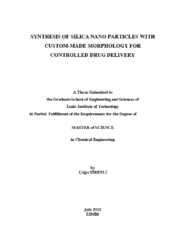Please use this identifier to cite or link to this item:
https://hdl.handle.net/11147/3475Full metadata record
| DC Field | Value | Language |
|---|---|---|
| dc.contributor.advisor | Polat, Mehmet | en |
| dc.contributor.author | Siretli, Çağrı | - |
| dc.date.accessioned | 2014-07-22T13:51:37Z | - |
| dc.date.available | 2014-07-22T13:51:37Z | - |
| dc.date.issued | 2012 | en |
| dc.identifier.uri | http://hdl.handle.net/11147/3475 | - |
| dc.description | Thesis (Master)--Izmir Institute of Technology, Chemical Engineering, Izmir, 2012 | en |
| dc.description | Includes bibliographical references (leaves: 93-103) | en |
| dc.description | Text in English; Abstract: Turkish and English | en |
| dc.description | xi, 103 leaves | en |
| dc.description | Full text release delayed at author's request until 2015.08.06 | en |
| dc.description.abstract | The purpose was to have nanosized particles with low energy perimeters which function as non-reacting transporters for targeted delivery along with high energy sites inside the pores to achieve controlled release of specialized chemicals. Surfactants were used in combination with both base and acid catalyzed methods to achive desired structural properties and the characterization studies such as SEM, TEM, FTIR, BET surface area, pore size, size and zeta potential measurements were conducted. The effect of surfactants on mesoporous silica production changed depending on the type of methods. In the case of base catalysed method in alcohol, formation of stabilized emulsions with different sizes and their effect on the size and shape of silica particles was proposed. The effect of surfactants was attributed to their effect on a) the emulsification process and b) silica-silica and silica-surfactant interactions involved. In the case of base catalysed silica production in water, however, surfactant micelles were used as templates to produce pores. The effect of surfactant type and concentration was attributed to their effect on the CMC, micelle shape and size. Rod-like (~400 nm) at high and spherical (~200 nm) particles at low concentrations were synthesized. Here the surface area of ~1000 m2/g and average pore size of ~3 nm were obtained. Carbonization of these materials were performed to obtain nanosized silica particles with low energy perimeters successfully. Acid catalysed silica production in water was similar. Rod-like (600-800 nm) and cubic (800-1000 nm) nanoparticles were produced. These particles exhibited lower surface area of ~700 m2/g and larger pore size of ~5 nm. | en |
| dc.language.iso | en | en_US |
| dc.publisher | Izmir Institute of Technology | en |
| dc.rights | info:eu-repo/semantics/embargoedAccess | en_US |
| dc.subject.lcsh | Nanoparticles | en |
| dc.subject.lcsh | Drugs--Controlled release | en |
| dc.subject.lcsh | Drug delivery systems | en |
| dc.title | Synthesis of silica nano particles with custom-made morphology for controlled drug delivery | en_US |
| dc.type | Master Thesis | en_US |
| dc.institutionauthor | Siretli, Çağrı | - |
| dc.department | Thesis (Master)--İzmir Institute of Technology, Chemical Engineering | en_US |
| dc.relation.publicationcategory | Tez | en_US |
| item.languageiso639-1 | en | - |
| item.fulltext | With Fulltext | - |
| item.openairecristype | http://purl.org/coar/resource_type/c_18cf | - |
| item.openairetype | Master Thesis | - |
| item.grantfulltext | open | - |
| item.cerifentitytype | Publications | - |
| Appears in Collections: | Master Degree / Yüksek Lisans Tezleri | |
Files in This Item:
| File | Description | Size | Format | |
|---|---|---|---|---|
| 439995.pdf | MasterThesis | 3.34 MB | Adobe PDF |  View/Open |
CORE Recommender
Page view(s)
114
checked on Jul 22, 2024
Download(s)
134
checked on Jul 22, 2024
Google ScholarTM
Check
Items in GCRIS Repository are protected by copyright, with all rights reserved, unless otherwise indicated.